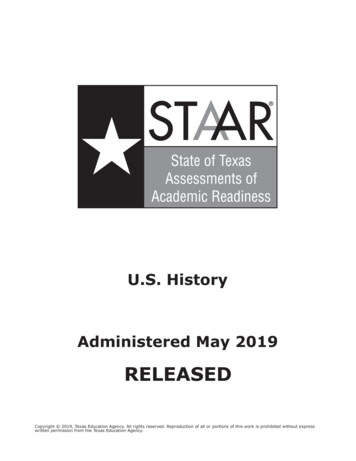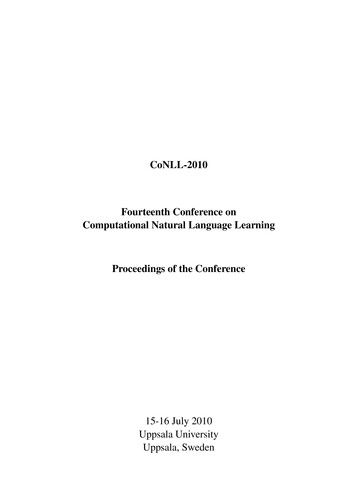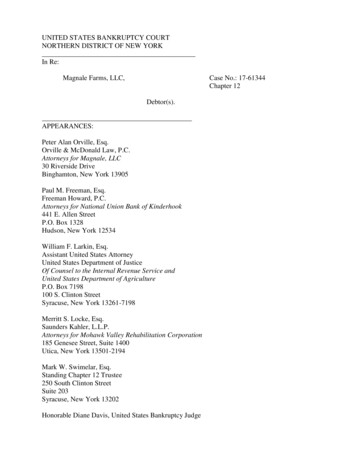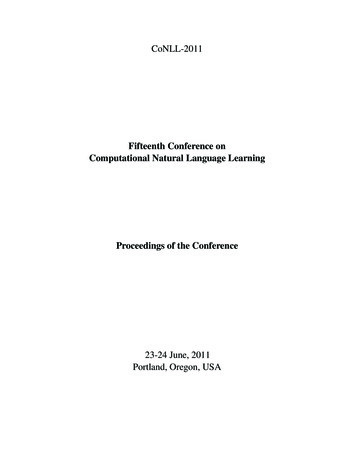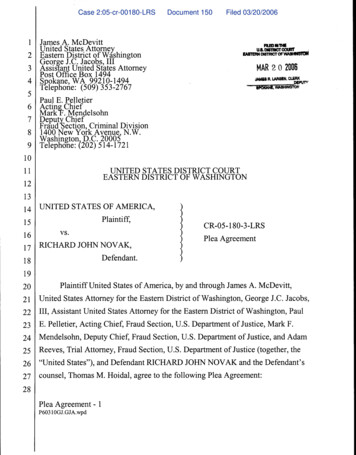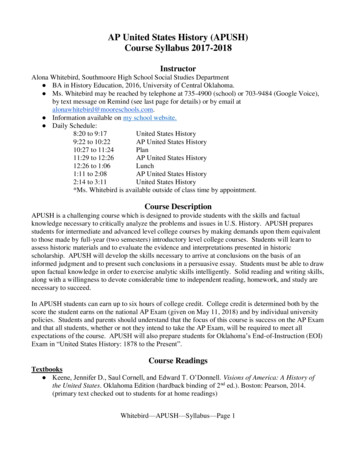
Transcription
AP United States History (APUSH)Course Syllabus 2017-2018InstructorAlona Whitebird, Southmoore High School Social Studies Department BA in History Education, 2016, University of Central Oklahoma. Ms. Whitebird may be reached by telephone at 735-4900 (school) or 703-9484 (Google Voice),by text message on Remind (see last page for details) or by email atalonawhitebird@mooreschools.com. Information available on my school website. Daily Schedule:8:20 to 9:17United States History9:22 to 10:22AP United States History10:27 to 11:24Plan11:29 to 12:26AP United States History12:26 to 1:06Lunch1:11 to 2:08AP United States History2:14 to 3:11United States History*Ms. Whitebird is available outside of class time by appointment.Course DescriptionAPUSH is a challenging course which is designed to provide students with the skills and factualknowledge necessary to critically analyze the problems and issues in U.S. History. APUSH preparesstudents for intermediate and advanced level college courses by making demands upon them equivalentto those made by full-year (two semesters) introductory level college courses. Students will learn toassess historic materials and to evaluate the evidence and interpretations presented in historicscholarship. APUSH will develop the skills necessary to arrive at conclusions on the basis of aninformed judgment and to present such conclusions in a persuasive essay. Students must be able to drawupon factual knowledge in order to exercise analytic skills intelligently. Solid reading and writing skills,along with a willingness to devote considerable time to independent reading, homework, and study arenecessary to succeed.In APUSH students can earn up to six hours of college credit. College credit is determined both by thescore the student earns on the national AP Exam (given on May 11, 2018) and by individual universitypolicies. Students and parents should understand that the focus of this course is success on the AP Examand that all students, whether or not they intend to take the AP Exam, will be required to meet allexpectations of the course. APUSH will also prepare students for Oklahoma’s End-of-Instruction (EOI)Exam in “United States History: 1878 to the Present”.Course ReadingsTextbooks Keene, Jennifer D., Saul Cornell, and Edward T. O’Donnell. Visions of America: A History ofthe United States. Oklahoma Edition (hardback binding of 2 nd ed.). Boston: Pearson, 2014.(primary text checked out to students for at home readings)Whitebird—APUSH—Syllabus—Page 1
Boyer, Paul S., Clifford E. Clark, Jr., Joseph F. Kett, Neal Salisbury, Harvard Sitkoff, and NancyWoloch. The Enduring Vision: A History of the American People. 6th ed. Boston: HoughtonMifflin, 2008. (single room set for student use within class)Primary Source Readers Bender, David L., pub. Opposing Viewpoints in American History. 1st ed. 2 vols. San Diego,CA: Greenhaven Press, Inc., 1996. Kennedy, David M. and Thomas A. Bailey. The American Spirit. 11th ed. 2 vols. Boston:Houghton Mifflin Company, 2006.Secondary Source Readers Oates, Stephen B. and Charles J. Errico. Portrait of America. 9th ed. 2 vols. Boston: HoughtonMifflin Company, 2007.Novels Shaara, Michael. The Killer Angels. New York: Ballantine Books, 1974. Sinclair, Upton. The Jungle. 1906. Ed. Paul Negri. Mineola, New York: Dover Publications,Incorporated, 2001.Other appropriate readings as selected by the teacherHistorical Thinking SkillsThroughout the course, APUSH will equip students to think and explore like historians. While suchskills are vital for success in APUSH and other “history” courses, these skills enhance students’ abilitiesto analyze information in a wide-range of other settings. The primary historical thinking skills on whichwill focus in APUSH are:1. Historical Causation: proficient students should be able to:a.b.c.compare causes and/or effects, including between short- and long-term effectsanalyze and evaluate the interaction of multiple causes and/or effectsassess historical contingency by distinguishing among coincidence, causation, and correlation, as well ascritiquing existing interpretations of cause and effect2. Patterns of Continuity and Change over Time: proficient students should be able to:a. analyze and evaluate historical patterns of continuity and change over timeb. connect patterns of continuity and change over time to larger historical processes or themes3. Periodization: proficient students should be able to:a.explain ways that historical events and processes can be organized within blocks of timeb. analyze and evaluate competing models of periodization of U.S. history4. Comparison: proficient students should be able to:a.b.compare related historical developments and processes across place, time, and/or different societies or withinone societyexplain and evaluate multiple and differing perspectives on a given historical phenomenon5. Contextualization: proficient students should be able to:a.b.explain and evaluate ways in which specific historical phenomena, events, or processes connect to broaderregional, national, or global processes occurring at the same timeexplain and evaluate ways in which a phenomenon, event, or process connects to other, similar historicalphenomena across time and place6. Historical Argumentation: proficient students should be able to:a.b.c.analyze commonly accepted historical arguments and explain how an argument has been constructed fromhistorical evidenceconstruct convincing interpretations through analysis of disparate, relevant historical evidenceevaluate and synthesize conflicting historical evidence to construct persuasive historical arguments7. Appropriate Use of Relevant Historical Evidence: proficient students should be able to:Whitebird—APUSH—Syllabus—Page 2
a.b.8.analyze features of historical evidence such as audience, purpose, point of view, format, argument, limitations,and context germane to the evidence consideredbased on analysis and evaluation of historical evidence, make supportable inferences and draw appropriateconclusionsInterpretation: proficient students should be able to:a.b.analyze diverse historical interpretationsevaluate how historians’ perspectives influence their interpretations and how models of historical interpretationchange over time9. Synthesis: proficient students should be able to:a.b.combine disparate, sometimes contradictory evidence from primary sources and secondary works in order tocreate a persuasive understanding of the pastapply insights about the past to other historical contexts or circumstances, including the presentThematic Learning ObjectivesTo help focus student understanding of major historical issues and developments and to recognize broadtrends and process within United States History, seven key themes will be used throughout the course.1. American and National Identity (NAT):a.b.c.d.How did ideas like democracy, freedom, & individualism shape the development of cultural values, politicalinstitutions, & what it means to be an “American”?How did interpretations of the Constitution & debates over rights, liberties, & citizenship affect Americanvalues, politics, & society?How have ideas about national identity changed in response to international conflicts & the expansion ofAmerican territory?How do the relationships & experiences of different regional, social, ethnic, & racial groups relate to Americannational identity?2. Work, Exchange, and Technology (WXT):a.b.c.How have different labor systems developed in North America & the United States? How have they effectedworkers’ lives & U.S. society?How have patterns of exchange, markets, & private enterprise developed? How have federal, state, & localgovernments responded to economic issues?How has technological innovation affected economic development & society?3. Migration and Settlement (MIG):a.b.What were the causes of migration to colonial North America and, later, the United States? How hasimmigration affected U.S. society?What are the causes of internal migration & settlement patterns in the United States? How has migrationaffected American life?4. Politics and Power (POL):a.b.c.How & why have political ideas, beliefs, institutions, party systems, & alignments developed & changed?How have popular movements, reform efforts, and activist groups sought to change American society &political or economic institutions?How have different beliefs about the federal government’s role in U.S. social & economic life affected politicaldebates & policies?5. America in the World (WOR):a.b.How has cultural interaction, cooperation, competition, and conflict between empires, nations, and peoplegroups influenced political, economic, and social developments within North America?What are the reasons for and the results of U.S. diplomatic, economic, & military initiatives in North America& overseas?6. Geography and the Environment (GEO):a.b.How have geographic & environmental factors shaped the development of various communities?How has competition for & debates over natural resources affected both interactions among different groups &the development of governmental policies?7. Culture and Society (CUL):a.How have religious groups & ideas affected American society & political life?Whitebird—APUSH—Syllabus—Page 3
b.c.d.How have artistic, philosophical, & scientific ideas developed & shaped society & institutions?How have ideas about women’s rights & gender roles affected society & politics?How have different group identities, including racial, ethnic, class, & regional identities, emerged & changedover time?Course OutlineThroughout each time period of study, APUSH will make use of appropriate textbook and othersupplementary readings, primary and secondary source documents, and a variety of both in and out ofclass activities to develop the themes and historic thinking skills noted above.Beginning of First Semester - August 18, 2017Unit One: Early Contacts Among Groups in North AmericaTime Period: 1491-16075% of AP Exam7 class daysReadings:Thematic Essential Questions: Visions of America: NAT: How did the identities of colonizing ando Chapter 1: People in Motionindigenous societies change as a result of contact Enduring Vision:in the Americas?o Chapter 1: Native Peoples of America WXT: How did the Columbian Exchange affectinteraction between Europeans and natives ando Chapter 2: The Rise of the Atlantic Worldamong indigenous societies in North America? Primary Sources: MIG: Where did different groups settle in theo American Spirit:Americas (pre-contact) and how and why did they “New World Beginnings”move to and within the Americas (post contact)? Secondary Sources: POL: How did Spain’s early entry intoo “1491” (Atlantic Monthly, March 2002)colonization in the Caribbean and Latin Americao Portrait of America:shape European and American developments in #1: “The American Holocaust: Columbusthe colonial era?and the Conquest of the New World” WOR: How did European attempts to dominate Other readings as selected by teacherthe Americas shape relations between AmericanIndians, Europeans, and Africans? GEO: How did pre-contact populations of NorthAmerica relate to their environments? How didcontact with Europeans and Africans change theserelations in North America? CUL: How did cultural contact challenge thereligious and other value systems of peoples fromthe Americas, Africa, and Europe?Major Topics: Life in North America prior to & at the time ofEuropean exploration American Indian, European, & African culturalexperiences motivation of explorationUnit Two: North American Societies in the Context of the Atlantic WorldTime Period: 1607-175410% of AP Exam13 class daysReadings:Themes: Visions of America: NAT: What were the chief similarities ando Chapter 2: Models of Settlementdifferences among the development of English,o Chapter 3: Growth, Slavery, and ConflictSpanish, Dutch and French colonies in America? Enduring Vision: WXT: How did distinct economic systems,o Chapter 2: The Rise of the Atlantic Worldincluding based on indentured servitude ando Chapter 3: The Emergence of ColonialAfrican slaves, develop in British North America?Whitebird—APUSH—Syllabus—Page 4
Societieso Chapter 4: The Bonds of EmpirePrimary Sources:o Opposing Viewpoints: “National/Economic v. Puritan Reasonsfor Colonizing America” “Bacon’s Rebellion: Justified Revolutionor Treasonous Insurrection?” “The Salem Witch Trials” “The Great Awakening: ReligiousRevival or Zealotry?”o American Spirit: “The Planting of English America” “Settling the Northern Colonies” “American Life in the SeventeenthCentury” “The Duel for North America”Secondary Sources:o Portrait of America: #2: “From These Beginnings” #3: “Black People in a White People’sCountry”Other readings as selected by teacherWhat was their effect on emerging cultural andregional differences? MIG: Why did various colonists go to the NewWorld? How did the increasing integration of theAtlantic world affect the movement of peoplesbetween its different regions? POL: In what ways did the British governmentseek to exert control over its American colonies inthe 17th and 18th centuries? WOR: How did the competition betweenEuropean empires around the world affectrelations among the various peoples in NorthAmerica? GEO: How and why did the English NorthAmerican colonies develop into distinct regions? CUL: How did the expansion of cultural contactthat took place with permanent colonization alterconditions in North America and affect intellectual and religious life, the growth of trade,and the shape of political institutions?Major Topics: differences/similarities of New England,Chesapeake, & South indentured servitude & race-based slavery impact of Bacon’s Rebellion, Enlightenment,Great Awakening, & MercantilismUnit Three: Birth of a New Nation and Struggle for IdentityTime Period: 1754-180012% of AP Exam17 class daysReadings:Themes: Visions of America: NAT: How did different social group identitieso Chapter 3: Growth, Slavery, and Conflictevolve during the revolutionary struggle? How didleaders of the new United States attempt to form ao Chapter 4: Revolutionary Americanational identity?o Chapter 5: A Virtuous Republic WXT: How did the newly independent Unitedo Chapter 6: The New Republic Enduring Vision:States attempt to formulate a national economy?o Chapter 5: Roads to Revolution MIG: How did the revolutionary struggle and itso Chapter 6: Securing Independence, Definingaftermath reorient relations with AmericanIndians and affect subsequent populationNationhoodmovements?o Chapter 7: Launching the New Republic POL: How did the ideology behind the revolution Primary Sources:affect power relationships among different ethnic,o Declaration of Independenceracial, and social groups?o Constitution WOR: How did the revolution become ano Opposing Viewpoints:international conflict involving competing ‘Is Parliament Abusing Rights ofEuropean and American powers?American?” GEO: How did the geographical and “Best Form of Government: Republic orenvironmental characteristics of regions openedPopular Democracy?”for settlement after 1763 affect their subsequent “Ratifying the Constitution”development? “The National Bank” CUL: Why did the patriot cause spread so quickly “The Alien & Sedition Acts”among the colonists after 1763? How did theo American Spirit:republican ideals of the revolutionary cause affect “Colonial Society on the Eve ofthe nation’s political culture after independence?Revolution”Major Topics: “The Duel for North America” Anglo-French wars & post war policies leading to “The Road to Revolution”imperial ruptureWhitebird—APUSH—Syllabus—Page 5
“America Secedes from the Empire” unity from Albany Plan, Common Sense, &“The Confederation and theContinental Congress(es)Constitution” advance/stifle of liberty & equality in Revolution “Launching the New Ship of state”era Articles of Confederation & shift to Constitution Secondary Sources:o Evangeline (epic poem) efforts and rationales of Federalists and Antio Portrait of America:Federalists #7: “John Adams and the Coming of the development of two-party systemRevolution” strict versus loose interpretation of the #8: “Thomas Jefferson and the MeaningsConstitutionof Liberty” status of women/ethnic minorities in new republic #9: “Miracle at Philadelphia” #10: “The Greatness of GeorgeWashington” #11: “The Personal Side of a DevelopingPeople” Other readings as selected by teacherUnit Four: Growing Pains of the New RepublicTime Period: 1800-184810% of AP Exam14 class daysReadings:Themes: Visions of America: NAT: How did debates over American democratico Chapter 7: Jeffersonian Americaculture and the proximity of many differento Chapter 8: Democrats and Whigscultures living in close contact affect changingdefinitions of national identity?o Chapter 9: Workers, Farmers, and Slaves WXT: How did the growth of mass manufacturingo Chapter 10: Revivalism, Reform, and Artisticin the rapidly urbanizing North affect definitionsRenaissanceof relationships between workers and employers? Enduring Vision:How did the continuing dominance of agricultureo Chapter 8: Jeffersonianism and the Era ofand the slave system affect Southern social,Good Feelingspolitical, and economic life?o Chapter 9: The Transformation of American MIG: How did the continued movement ofSocietyo Chapter 10: Democratic Politics, Religiousindividuals and groups into, out of, and within theUnited States shape the development of newRevival, and Reformcommunities and the evolution of oldo Chapter 11: Technology, Culture, andcommunities?Everyday Life POL: How did the growth of mass democracy, Primary Sources:including such concerns as expanding suffrage,o Opposing Viewpoints:public education, abolitionism, and care for the “The Louisiana Purchase”needy, affect political life and discourse? “Federal Government Supremacy” WOR: How did the United States use diplomatic “Should Indians be Moved West?”and economic means to project its power into the “Do Immigrants Endanger America?”western hemisphere? How did foreigno American Spirit:governments and individuals describe and react to “The Triumphs and Travails of thethe new American nation?Jeffersonian Republic” GEO: How did environmental and geographic “The Second War for Independence andfactors affect the development of sectionalthe Upsurge of Nationalism”economics and identities? “The Rise of Mass Democracy” CUL: How did the idea of democratization shape “The Ferment of Reform and Culture”and reflect American arts, literature, ideals, and Secondary Sources:culture?o Portrait of America:Major Topics: #13: “The Duel” status of women/ethnic minorities in new republic #14: “The Great Chief Justice” Jefferson & public expenditures, judiciary, & the #15: “The Fires of Jubilee: Nat Turner’sWestFierce Rebellion” War of 1812’s influence on domestic & foreign #16: “‘I Will Be Heard!’: William LloydpoliciesWhitebird—APUSH—Syllabus—Page 6
Garrison and the Struggle Against influence of transportation & industrialSlavery”developments #17: “Andrew Jackson: Flamboyant Hero expansion of democracy & 2nd party system underof the Common Man”Jackson #19: “The Erie Canal: The Waterway challenges to federal authorityThat Shaped a Great Nation” impact of religious & reform movements #20: “Camelot on the Merrimack” response of authors/artists to technological, #21: “The Trail of Tears”economic, social progress Other readings as selected by teacherUnit Five: Expansion, Regional Separation, the Civil and Its AftermathTime Period: 1844-187713% of AP Exam19 class daysReadings:Themes: Visions of America: NAT: How did migration to the United Stateso Chapter 11: To Overspread the Continentchange popular ideas of American identity ando Chapter 12: Slavery and Sectionalismcitizenship as well as regional and racialo Chapter 13: A Nation Torn Apartidentities? How did the conflicts that led to theCivil War change popular ideas about national,o Chapter 14: Now That We Are Freeregional, and racial identities throughout the mido Chapter 15: Conflict and Conquest19th century? Enduring Vision: WXT: How did the maturing of Northerno Chapter 12: The Old South and Slaverymanufacturing and the adherence of the South too Chapter 13: Immigration, Expansion, andan agricultural economy change the nationalSectional Conflicteconomic system by 1877?o Chapter 14: From Compromise to Secession MIG: How did the growth of mass migration too Chapter 15: Crucible of Freedom: Civil Warthe United States and the railroad affect settlemento Chapter 16: The Crisis of Reconstructionpatterns in cities and the West?o Chapter 17: The Transformation of the Trans POL: Why did attempts at compromise before theMississippian WestCivil War fail to prevent the conflict? To what Primary Sources:extent, and in what ways, did the Civil War ando Opposing Viewpoints:Reconstruction transform American political and “Purpose of the Mexican War”social relationships? “Morality of Slavery” WOR: How was the American conflict over “Legality of Secession”slavery part of larger global events? “Civil War to End Slavery” GEO: How did the end of slavery and “Post-Slavery Segregation”technological and military developmentso American Spirit:transform the environment and settlement patterns “The South and the Slavery Controversy”in the South and the West? “Manifest Destiny and Its Legacy” CUL: How did the doctrine of Manifest Destiny “Renewing the Sectional Struggle”affect debates over territorial expansion and the “Drifting Toward Disunion”Mexican War? How did the Civil War shape “Girding for War: The North and theAmericans’ beliefs about equality, democracy,South”and national destiny? “The Furnace of Civil War”Major Topics: “The Ordeal of Reconstruction” social division of southern whites Secondary Sources: development of distinct slave cultureo Portrait of America: impact of antebellum immigration #22 “Women and Their Families on the westward expansion & sectional party conflictOverland Trails” justifications of pro- & anti- slavery arguments #24: “Let My People Go: Harriet influence of Compromise of 1850, KansasTubman and the Underground Railroad”Nebraska Act & election of 1860 #25: “John Brown: The Father of differences/similarities of North/South in CivilAmerican Terrorism”War #26: “Lincoln’s Journey to impact of African-Americans & Emancipation onEmancipation”Civil War’s outcome #27: “The Ravages of War” influence of Civil War on political, social, #30 (end of volume 1): “The Checkeredeconomic, & sectional characteristicsWhitebird—APUSH—Syllabus—Page 7
various plans for Reconstruction & era’s impactagricultural, social, & political policies to recreate“slavery” in South factors leading to end of Reconstruction impact of railroad, mining, ranching, Homestead Act, & federal Indian policy impact of Westward settlement on women/ethnicgroups & conservationEnd of First Semester—Semester Exams—December 19 & 20, 2017Beginning of Second Semester—January 3, 2018Unit Six: Industrialization, Urbanization, and Cultural TransformationTime Period: 1865-189813% of AP Exam18 daysReadings:Themes: Visions of America: NAT: How did the rapid influx of immigrantso Chapter 16: Wonder and Woefrom parts of the world other than northern ando Chapter 17: Becoming a Modern Societywestern Europe affect debates about American Enduring Vision:national identity? WXT: How did technological and corporateo Chapter 18: The Rise of Industrial Americainnovations help to vastly increase industrialo Chapter 19: Immigration, Urbanization, andproduction? What was the impact of theseEveryday Lifeinnovations on the lives of working people?o Chapter 20: Politics and Expansion in an MIG: How and why did the sources of migrationIndustrializing Ageto the United States change dramatically at the Primary Sources:end of the 19th century?o Opposing Viewpoints: POL: How did the political culture of the Gilded “Chinese Immigration”Age reflect the emergence of new corporate “Do Concentrations of Wealth Harm orpower? Why did challenges to this power fail?Help America?” WOR: How did the search for new global markets “Role of Labor Unions”affect American foreign policy and territorialo American Spirit:ambitions? “Political Paralysis in the Gilded Age” GEO: In what ways and to what extent was the “Industry Comes of Age”West opened for further settlement through “America Moves to the City”connection to Eastern political, financial and “The Great West and the Agriculturaltransportation systems?Revolution” CUL: How did artistic and intellectual movements Secondary Sources:both reflect and challenge the emerging corporateo Portrait of America:power? #5: “The Master of Steel: AndrewMajor Topics:Carnegie” technological innovations & business practices #7: “A Little Milk, A Little Honey:impact industrial productionJewish Immigrants to New York City” changing nature of “work”, growth of The Jungle (novel)corporations, immigrants, and labor Other readings as selected by teacher influence of federal policy on corporate world Industrial Revolution & conflicting socialideologies economic, social, & political factors shaping citychanges agrarian culture issues of discontent in national policiesUnit Seven: Domestic and Global Challenges and the Creation of Mass CultureTime Period: 1890-194517% of AP Exam24 daysReadings:Themes: Visions of America: NAT: How did continuing debates overo Chapter 18: Creating a Democratic Paradiseimmigration and assimilation reflect changingo Chapter 19: Imperial Americaideal of national and ethnic identity? How didHistory of the Great FourteenthAmendment” #3 (start of volume 2): “Sitting Bull andthe Sioux Resistance”The Killer Angels (novel)Other readings as selected by teacherWhitebird—APUSH—Syllabus—Page 8
o Chapter 20: The Great Waro Chapter 21: A Turbulent Decadeo Chapter 22: A New Deal for Americao Chapter 23: World War IIEnduring Vision:o Chapter 20: Politics and Expansion in anIndustrializing Ageo Chapter 21: The Progressive Erao Chapter 22: Global Involvements and WorldWar Io Chapter 23: The 1920s: Coping with Changeo Chapter 24: The Great Depression and theNew Dealo Chapter 25: Americans and a World in CrisisPrimary Sources:o Opposing Viewpoints: “Booker T. Washington v. W.E.B. DuBois” “America and the Philippines” “World War I and Freedom of Speech” “U.S. Membership in League of Nations” “Do Immigrants Harm AmericanSociety?” “The New Deal” “Lend-Lease Aid to Britain” “Japanese Internment Justified?”o American Spirit: “Progressivism and the RepublicanRoosevelt” “Wilsonian Progressivism at Home andAbroad” “The War to End War” “American Life in the ‘RoaringTwenties’” “The Politics of Boom and Bust” “The Great Depression and the NewDeal” “Franklin D. Roosevelt and the Shadowof War” “America in World War II”Secondary Sources:o Portrait of America: #8: “The Lady Versus Goliath: IdaTarbell Takes on Standard Oil Co.” #9: “America’s First Southeast AsianWar: The Philippine Insurrection” #10: “Theodore Roosevelt, President” #11: “African Americans and the Questfor Civil Rights #12: “Suffragists’ Storm OverWashington” #14: “Henry Ford: Symbol of an Age” #15: “Justice Denied: The Trial of Saccoand Vanzetti” #16: “Under Hoover, the Shame andMisery Deepened”class identities change in the first half of the 20 thcentury? WXT: How did Progressive movements forpolitical and economic reform take shape and howeffective where they in achieving their goals? MIG: Why did public attitudes towardsimmigration become negative following WorldWar I? How and why did people migrate withinthe U.S. between the world wars? POL: How did reformist ideals change as theywere taken up by reformers in different timeperiods? Why did opposition emerge to variousreform programs? WOR: Why did U.S. leaders decide to becomeinvolved in global conflicts such as the SpanishAmerican War, World War I, and World War II?How did debates over intervention reflect publicviews of America’s role in the world? GEO: Why did reformers seek for the governmentto wrest control of the environment and nationalresources from commercial interests? CUL: How did modern cultural values evolve inresponse to developments in technology? How diddebates over the role of women in public lifereflect changing social realities?Major Topics: progressive reform at local, state, & nationallevels involvement & success of women in reformmovements concerns of African-Americans addressed bygovernment & reform organizations late 1800s expansionist pressures neutrality shifting to involvement in World War I home front climate, especially for women andethnic minorities Treaty of Versailles as “vindication” of U.S.involvement in World War I economic development of 1920s, “mass culture”& consumer economy social & political ideology of Harding, Coolidge,& Hoover developments contributing to cultural creativity &social tension factors contributing to & political/social effects ofStock Market Crash & Great Depression economic, social, & political theories of FDR’sNew Deal extent that New Deal was embraced by politicalLeft & Right U.S. response to rise of fascism & militarism in1930s Military & economic mobilization for war neutrality shifting to US involvement in WorldWar II effects of World War II on US geographic regionsWhitebird—APUSH—Syllabus—Page 9
#17: “Government in Action: FDR and& women/ethnic minoritiesthe Early New Deal” federal efforts to protect home front from internal Portrait #19: “America and the& external threatsHolocaust” short & long term Allied goals, especially as #20: “The Biggest Decision: Why Weexpressed at wartime conferencesHad to Drop the Atomic Bomb” The Jungle (novel) Other readings as selected by teacherUnit Eight: Increasing Prosperity and Global Responsibility After World War IITimer Period: 1945-198015% of
AP United States History (APUSH) Course Syllabus 2017-2018 Instructor Alona Whitebird, Southmoore High School Social Studies Department BA in History Education, 2016, University of Central Oklahoma. Ms. Whitebird may be reached by t





